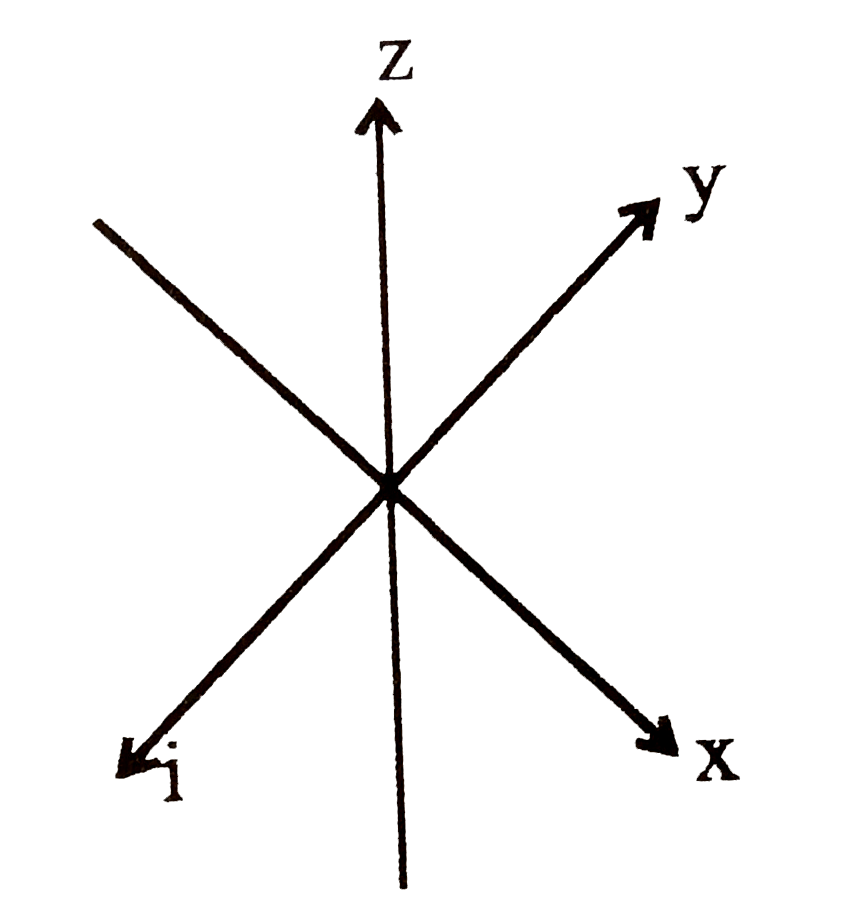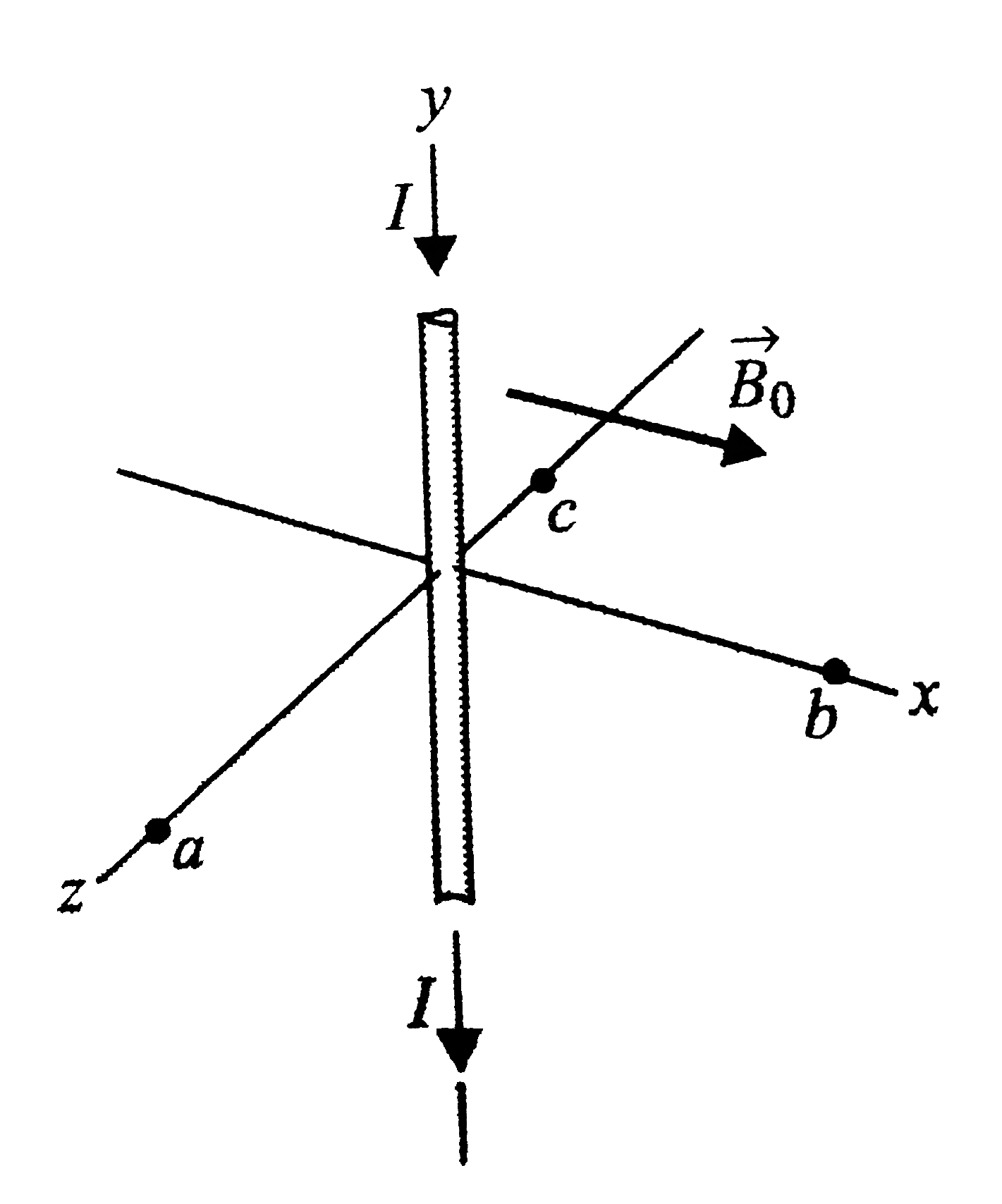A +6μC point charge is moving at a constant velocity of 8×106ms−1 in the +y direction, relative to a reference frame. At the instant when the point charge is at the origin of this reference frame, what is the magnetic field vector it produces at the following points?
(a) x=0.500m,y=0,z=0, and (b) x=0,y=−0.500m,z=0.
To solve the problem of finding the magnetic field produced by a moving point charge at two specified points, we will use the Biot-Savart Law. Here’s a step-by-step solution:
Step 1: Calculate the Magnetic Field at Point A
1. Identify the position vector r from the charge to point A:
r=(0.5^i+0^j+0^k)−(0^i+0^j+0^k)=0.5^i
2. Calculate the magnitude of r:
r=|r|=0.5m
3. Determine the unit vector ^r:
^r=rr=^i
4. Use the Biot-Savart Law:
B=μ04πqv×rr3
where μ0=4π×10−7T⋅m/A.
5. Calculate v×r:
- v=8×106^j
- r=0.5^i
v×r=(8×106^j)×(0.5^i)=4×106^k
6. Substitute into the Biot-Savart Law:
BA=(4π×10−7)4π(6×10−6)(4×106)^k(0.5)2
=10−7(24×100)^k0.25=10−7×96^k=9.6×10−6^kT
Step 2: Calculate the Magnetic Field at Point B
1. Identify the position vector r from the charge to point B:
r=(0^i+(−0.5)^j+0^k)−(0^i+0^j+0^k)=−0.5^j
2. Calculate the magnitude of r:
r=|r|=0.5m
3. Determine the unit vector ^r:
^r=rr=−^j
4. Use the Biot-Savart Law:
B=μ04πqv×rr3
5. Calculate v×r:
- v=8×106^j
- r=−0.5^j
v×r=(8×106^j)×(−0.5^j)=0
6. Substitute into the Biot-Savart Law:
BB=0
Final Results:
- Magnetic Field at Point A: BA=9.6×10−6^kT
- Magnetic Field at Point B: BB=0
1. Identify the position vector r from the charge to point A:
r=(0.5^i+0^j+0^k)−(0^i+0^j+0^k)=0.5^i
r=|r|=0.5m
^r=rr=^i
B=μ04πqv×rr3
where μ0=4π×10−7T⋅m/A.
- v=8×106^j
- r=0.5^i
v×r=(8×106^j)×(0.5^i)=4×106^k
BA=(4π×10−7)4π(6×10−6)(4×106)^k(0.5)2
=10−7(24×100)^k0.25=10−7×96^k=9.6×10−6^kT
1. Identify the position vector r from the charge to point B:
r=(0^i+(−0.5)^j+0^k)−(0^i+0^j+0^k)=−0.5^j
r=|r|=0.5m
^r=rr=−^j
B=μ04πqv×rr3
- v=8×106^j
- r=−0.5^j
v×r=(8×106^j)×(−0.5^j)=0
BB=0
- Magnetic Field at Point A: BA=9.6×10−6^kT
- Magnetic Field at Point B: BB=0
Topper's Solved these Questions
- BOOK - CENGAGE PHYSICSCHAPTER - SOURCES OF MAGNETIC FIELDEXERCISE - Concept Exercise 2.210videos
SOURCES OF MAGNETIC FIELD
- BOOK - CENGAGE PHYSICSCHAPTER - SOURCES OF MAGNETIC FIELDEXERCISE - Exercise (subjective )10videos
SOURCES OF MAGNETIC FIELD
- BOOK - CENGAGE PHYSICSCHAPTER - SOURCES OF MAGNETIC FIELDEXERCISE - Solved Example20videos
SOURCES OF MAGNETIC FIELD
- BOOK - CENGAGE PHYSICSCHAPTER - SEMICONDUCTOR ELECTRONIC : MATERIALS, DEVICES AND SIMPLE CIRCUITSEXERCISE - QUESTION BANK12videos
SEMICONDUCTOR ELECTRONIC : MATERIALS, DEVICES AND SIMPLE CIRCUITS
- BOOK - CENGAGE PHYSICSCHAPTER - THERMAL PROPERTIES OF MATTEREXERCISE - Question Bank40videos
THERMAL PROPERTIES OF MATTER
Similar Questions
In a certain region of space, the electric field is along +y-direction and has a magnitude of 400 V/m . What is the potential difference from the coordinate origin to the following points?
a.x=0,y=20cm,z=0
b. x=0,y=−30cm,z=0
c.x=0,y=0,z=15cmView SolutionA point charge q=−8.0nC is located at the origin. Find the electric field vector at the point x=1.2m,y=−1.6m.
View Solution
Knowledge Check
- Question 1 - Select One
Positive point charge q=+8.00μCandq'=+3.00μC are moving relative to an observer in Fig. The distance d is 0.120m. When the two charges are at the locations shown in the figure, what are the magnitude and direction of the net magnetic field they produce at point P? (Takev=4.50×106ms−1andv'=9.00×106ms1)
 A4.38×10−4T, into the pageB4.38×10−4T, out of the pageC2.16×10−4T, into the pageD2.16×10−4T, out of the page
A4.38×10−4T, into the pageB4.38×10−4T, out of the pageC2.16×10−4T, into the pageD2.16×10−4T, out of the page
A long straight wire carries a current of 10A directed along the negative y-axis as shown in A unifrom magnetic field B0 of magnetude 10−6T is directed parallel to the x-axis What is the resultant magnetic field at the following points
(a) x=0,z=2m, (b) x=2m,z=0 (c) x=0,z=−0.5m
 .View Solution
.View SolutionWith what velocity (relative to the reference frame K) did the clock move, if during the time interval t=5.0s, measured by the clock of the frame K, it becomes slow by Δt=0.10s?
View SolutionTwo charges - q and +q are located at points (0, 0, - a) and (0,0, a), respectively.
What is the electrostatic potential at the points (0, 0, z) and (x, y,0) ?View SolutionA long, straight wire lies along the y-axis and carries a current I=8A in the y-direction (as shown in Fig) In addition to the magnetic field due to the current in the wire, a uniform magnetic field →B0 with magnitude 1.50×10−6T is in the +x direction. What is the total field (magnitude and direction ) at following points in the plane?
(a)x=0,z=1.00m
(b) x=1.00m,z=0
(c) x=0,z=−0.25m
 View Solution
View SolutionWhat is the locus of a point (x,y,z) for which y=0,z=0?
View SolutionThere is a constant homogeneous electric field of 100Vm−1 within the region x=0andx=0.167m pointing in x-direction. There is a constant homogeneous mangetic field B within the region x=0.167mandx=0.334m pointing in the z-direction. A proton at rest at the origin is released in positive x-direction. Find the minimum strength of the magnetic field B, so that the proton is detected back at x=0,y=0.167m. (mass of proton =1.67×10−27kg)
View SolutionA particle of mass 1×10−26kg and charge +1.6×10−19C travelling with a velocity 1.28×106ms−1 in the +x direction enters a region in which uniform electric field E and a uniform magnetic field of induction B are present such that Ex=Ey=0,Ez=−102.4kVm−1,andBx=Bz=0,By=8X10−2. The particle enters this region at time t=0. Determine the location (x,y,z coordinates) of the particle at t=5×10−6s. If the electric field is switched off at this instant (with the magnetic field present), what will be the position of the particle at t=7.45×10−6s ?
View Solution

